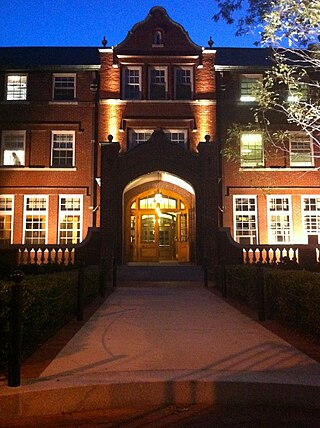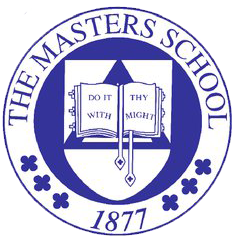Progressive education, or educational progressivism, is a pedagogical movement that began in the late 19th century and has persisted in various forms to the present. In Europe, progressive education took the form of the New Education Movement. The term progressive was engaged to distinguish this education from the traditional curricula of the 19th century, which was rooted in classical preparation for the early-industrial university and strongly differentiated by social class. By contrast, progressive education finds its roots in modern, post-industrial experience. Most progressive education programs have these qualities in common:

Lincoln Center for the Performing Arts is a 16.3-acre (6.6-hectare) complex of buildings in the Lincoln Square neighborhood on the Upper West Side of Manhattan. It has thirty indoor and outdoor facilities and is host to 5 million visitors annually. It houses internationally renowned performing arts organizations including the New York Philharmonic, the Metropolitan Opera, the New York City Ballet, the Chamber Music Society of Lincoln Center, and the Juilliard School.

Barrie School is a progressive independent school for students age 12 months through Grade 12 located in an unincorporated area of Montgomery County, Maryland, outside of Washington, D.C. The school is within the Glenmont census designated place, has a Silver Spring postal address, and is in close proximity to Layhill. Barrie School is a nonprofit school with 501(c)(3) status.

The New York University College of Dentistry is the dentistry school of New York University. As the 3rd oldest dentistry school in the United States, it offers both graduate programs and clinical training in oral healthcare.

Associação Escola Graduada de São Paulo, most commonly referred to as Graded School or Graded, is an American school in São Paulo, Brazil. The school opened on October 17, 1920, in a small schoolhouse on Avenida São João, and in 1961 the current campus was built on Avenida Giovanni Gronchi, in a terrain now facing Paraisópolis, located in Morumbi.

Wheeler School is a private school located on the East Side of Providence, Rhode Island, United States. The school serves students from the nursery level through twelfth-grade.

Alice Tully Hall is a concert hall at the Lincoln Center for the Performing Arts in the Upper West Side neighborhood of Manhattan in New York City. The hall is named for Alice Tully, a New York performer and philanthropist whose donations assisted in the construction of the hall. Tully Hall is located within the Juilliard Building, a Brutalist structure, which was designed by architect Pietro Belluschi. It was completed and subsequently opened in 1969. Since its opening, it has hosted numerous performances and events, including the New York Film Festival. Tully Hall seats 1,086 patrons. It is the home of the Chamber Music Society of Lincoln Center.

MLC School is an independent Uniting Church single-sex early learning, primary, and secondary day school for girls, located in the inner western Sydney suburb of Burwood, New South Wales, Australia. The school enrols students from early learning, through kindergarten to year 12.

The Masters School, is a private, coeducational boarding school and day college preparatory school located in Dobbs Ferry, New York. Its 96-acre (390,000 m2) campus is located north of New York City in the Hudson Valley in Westchester County. It was founded as an all-girls private school in 1877 by Eliza Bailey Masters, and first admitted boys in 1996.

Saint Mary's Hall (SMH) is a private college preparatory school in San Antonio, Texas. Saint Mary's Hall admits students from Montessori to Form 12.

Kent Denver School is a private, co-educational, non-sectarian college preparatory high school and middle school in Cherry Hills Village, Colorado. It traces its origin back to the 1922 founding of the Kent School for Girls and has existed as a co-educational institution since 1974.

599 Lexington Avenue is a 653 ft (199m) tall, 50-story skyscraper in Midtown Manhattan, New York City, designed by Edward Larrabee Barnes/John MY Lee Architects. It was the first building constructed by Mortimer Zuckerman and his company Boston Properties in New York City. The site was acquired for $84 million in 1984, and completed in 1986. The building is adjacent to the Citicorp Tower and is considered a well-designed contextual partner to the area. The entryway to the Lexington Ave. subway features a glass shed canopy that pays homage to the Citicorp Tower roof.

41 Park Row, also 147 Nassau Street and formerly the New York Times Building, is an office building in the Financial District of Manhattan in New York City, across from City Hall and the Civic Center. It occupies a plot abutting Nassau Street to the east, Spruce Street to the north, and Park Row to the west. The building, originally the headquarters of The New York Times, is the oldest surviving structure of Lower Manhattan's former "Newspaper Row" and has been owned by Pace University since 1951.
The Hewitt School is a K-12 independent girls' school located on New York City's Upper East Side. The school teaches girls to become ethical leaders. The school serves girls in three divisions: Lower School (K-4), Middle School (5-8), and Upper School (9-12).

Rosemary Hall was an independent girls school at Ridgeway and Zaccheus Mead Lane in Greenwich, Connecticut. It was later merged into Choate Rosemary Hall and moved to the Choate boys' school campus in Wallingford, Connecticut.
Latin American Montessori Bilingual Public Charter School is a public charter school in Washington, D.C. It operates in two buildings in the Northwest and Northeast quadrants of the city: one on 14th Street in Northwest's Sixteenth Street Heights and one at the corner of Perry Street and South Dakota Avenue in Northeast's Brookland neighborhood.

The Duane Doty School is a school building located at 10225 3rd Street in Detroit, Michigan. It was listed on the National Register of Historic Places in 2011. It is the oldest Arts and Crafts-style school building in Detroit, and likely one of the oldest Arts and Crafts-style schools in Michigan.
FXCollaborative is an American architecture, planning, and interior design firm founded in 1978 by Robert F. Fox Jr. and Bruce S. Fowle as Fox & Fowle Architects. The firm merged with Jambhekar Strauss in 2000 and was renamed to FXFOWLE Architects in 2005 following Fox's departure. The firm was renamed to FXCollaborative on January 18, 2018. The firm is best known for projects in New York City including the Condé Nast Building, Reuters Building, Eleven Times Square, renovation of the Jacob K. Javits Convention Center, and the Statue of Liberty Museum.

The Robert and Anne Dickey House, also referred to as the Robert Dickey House or by its address 67 Greenwich Street, is a Federal-style building in the Financial District of Lower Manhattan in New York City. The site is bounded by Edgar Street to the south, Greenwich Street to the west, and Trinity Place to the east. It is named after Robert Dickey, a 19th-century New York merchant, and his wife Anne, who both resided in the house. Erected circa 1810, it is one of the few remaining Federal-style buildings in the city, and became a New York City designated landmark in 2005. Having stood for over 200 years, surviving the construction of several subway lines and the Brooklyn–Battery Tunnel, as well as the September 11 attacks, the building has been labeled as a "Robert Moses survivor" and "The Indestructible Townhouse".
Mary Edwards Calhoun was the Calhoun School headmistress from 1916 to 1942.

















